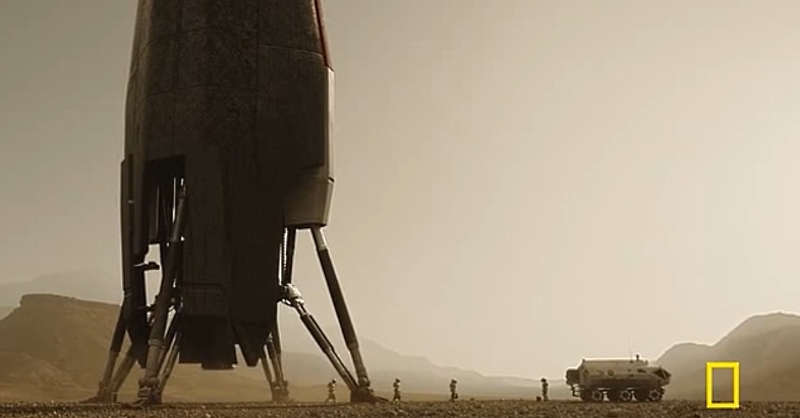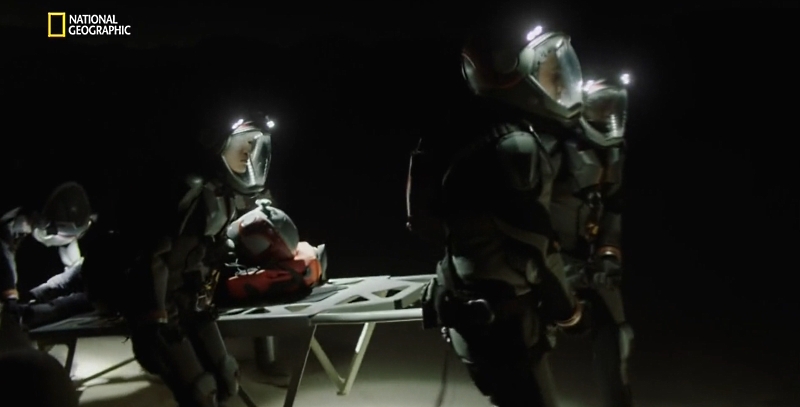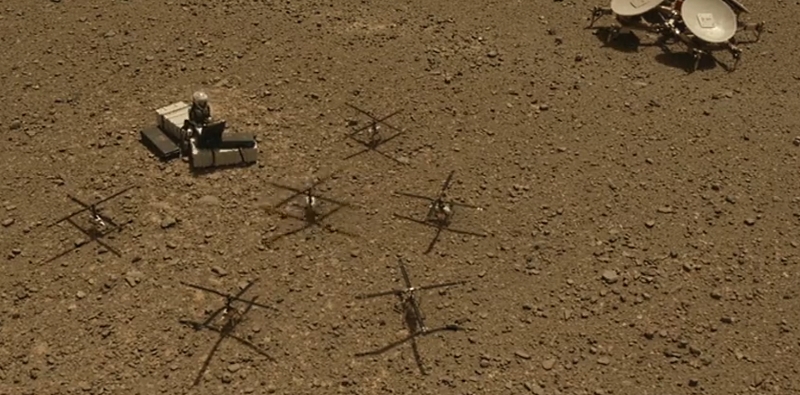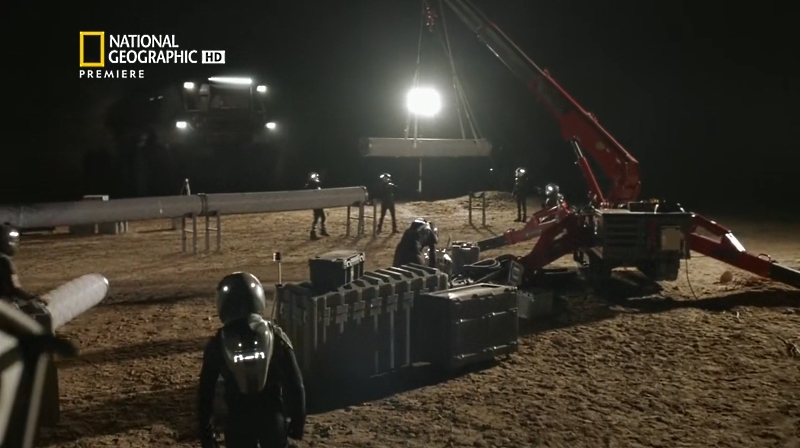The series "Mars": False accidents and ecology instead of astronautics
In the comments to the review of the TV series “First” I was asked to express an opinion on the TV series “Mars” of National Geographic. At that time, the release of the second season was expected, so I decided to watch it, and then write a review. The last episode was released on December 17th. If very briefly, the first season is so-so, the second is more cheerful, but worse, and for the analysis of technology, the plot and other aspects I ask under the cat. Also there are spoilers, but fairly moderate.

Series poster
The first season came out in 2016 and begins, in fact, right from the landing - very briefly saying that "the leading space agencies have teamed up with private companies in the International Martian Scientific Organization (IMNO, IMSF) to go to Mars", and through the crew’s official presentation we are shown characters. Six people are flying to the red planet - two Americans, a Frenchwoman, a Spaniard, a Russian woman with a typically Russian name, Martha Kamen, and, suddenly, a Nigerian citizen. IMNO leads an allusion to a mask named Ed Grann. What difficulties we had to overcome in order to assemble, organize, find money, build and test ships, etc., we were not shown.
The feature of the series is the constant leaps between modernity, where real events like the first landing of the Falcon 9 are shown to us, and the fantastic exploration of Mars in the 2030s. A matter of taste, but in my opinion, this added inconsistency in the presentation.

Shot from the series
So, the first ship (in which, by the way, ITS SpaceX, announced just in the fall of 2016) is easily recognized, enters the atmosphere of Mars to land. Immediately revealed a problem with which, unfortunately, begins many questions to the technical accuracy of the series. The fact is that in real life the spacecraft systems are checked before important operations. This is very logical, because during the seven months of the flight, the technician may fail imperceptibly. And since the date of arrival is known in advance, no one bothers to spend at least a week before boarding to check the systems. Further, the elementary design logic says not to install critical electronics in one unit whose failure puts the mission at risk. There is no time for the commander’s heroism, and the reduction ballistics is not actually shown.

Night, the batteries are sitting down, the wounded commander is on the cart.
After landing far from the target, it suddenly turns out that the ship has life-support supplies for only three days. It looks implausible, because to fly seven months with so limited reserves is too much risk. Further, the flight duration implies at least a partially closed life support system, from which, by design, it would be possible to squeeze more than three days. But this is necessary according to the plot - the writers wanted to show a heroic transition to the base camp. It takes the entire second series. And the plot decisions that looked good in the “Country of Crimson Clouds” are puzzling here - if you normally planned a mission for such heroism, there would be no trivial prerequisites.

Drones on Mars. The first, by the way, should fly with the NASA 2020 rover.
The third series talks about finding a suitable place to deploy a permanent base. And the new drama again raises the question of mission planning. Obvious logic dictates that by the time people arrived, the remote-controlled machines from the Earth should already have been able to reconnoiter several potentially suitable places at the same time — wasting precious resources in search of what could be found in advance was completely irrational. The finale is utterly utterly up to the worn “last meter of cable” stamp.

Base in the lava tube
The fourth series is devoted to the development of the base and the arrival of the second ship and I liked it more than the other series of the season, mainly because of the interesting frames of the real part. The creators of the series compare the Martian base with the Antarctic research stations, it is obvious, but still curious. At the same time, it was not without its oddities. Psychologically unreliable, the meeting looks like people who have been on Mars for four years, new astronauts - greetings look ordinary, although even on the ISS there is a fountain of emotions in such cases. And Martha has grown so stony nerves that she continues to look for life, without being distracted by any human trifles. The situation when haste leads to problems is the most logical thing that the writers come up with, but even here the course of the accident was greatly simplified, forgetting that the reactor’s emergency withdrawal is a lengthy operation that requires a separate power source, and this is despite the fact that the history of Fukushima is still well known. Alas, the series ends with a completely anecdotal footage of a dust storm with lightning bolts with other special effects, clearly copied from terrestrial conditions.

Shot from the film The
real dust storm on Mars, of course, impairs visibility and falls asleep solar panels, but it looks much less dramatic.
In the fifth series, the contrived drama reaches a climax - the reactor is still not working, the solar panels are falling asleep, emergency measures are ineffective, and there is a severe shortage of electricity at the base, which also adds psychological problems. In this case, the first crew has already experienced a dust storm in 2035 and, in theory, should support newcomers. Alas, the series shows that the selection should be done carefully, and on the spot it is necessary to look after the psychological state of the crew. The scene of the heroic repair of the electrical system in zero visibility conditions is ugly - if you got rid of the safety cable, then even if you found the place of the accident, you can only return to the rover by a miracle. Well, the plausibility is lame - if the accident can be fixed by one person with a tool box, who prevented to do it before? The second incident raises questions to the design of the base,
Well, the sixth series in the worst traditions of deus ex machina rescues the seemingly doomed Martian base.
In general, the season looks so-so - there is little useful knowledge about Mars (and where did they land at all? And why there?), The characters are stilted, the accidents are far-fetched, the atmosphere is generally gloomy.
The second season, after a two-year break, puts the gas pedal on the floor. The yard is only 2042 (the first six people landed in 2033, the second six in 2037), but two hundred people work on the surface, a Chinese station flies in orbit, and this whole crowd produces mirrors for the terraforming of the planet. The idea is vigorous, but completely unrealizable for several reasons at once. First of all, fresh researchNASA says that if we melt all the water, carbon dioxide, etc., then the atmospheric pressure will rise from 0.6% of the earth's to just 6.9%. Further, since you found life on the planet in the first season, you can forget about terraforming - no one will let you destroy the ecosystems living in today's Martian conditions. Finally, without engineering solutions of the planetary level, this atmosphere will be lost just as it was the first time. However, the mirror is mentioned briefly, and it is not clear what exactly these two hundred people are busy with.
Especially ridiculous insolent terraforming of Mars looks against the background of the fact that the documentary half of the season is devoted to global warming on Earth. Now the main characters, who occupy more screen time than Mask himself, are environmental activists. In general, alas, politics has become more, and it is clearly working out the current agenda - “bad Russia” hides the anthrax epidemic, “bad China” hides atypical pneumonia, “bad Trump” does not fight against global warming. In my opinion, mixing it up with science is wrong - the relations of the countries will change in the future, and the series will become an anecdote, while Klushantsev’s completely apolitical films are fun to watch now.
The main source of the drama of the second season is the private corporation Lukrum, which lands its expedition to Mars with the aim of obtaining what is not clear. I honestly carefully watched all the episodes, but the audience did not say that they found such precious there. For reference: there is a crater in Siberia Popigay , where the impact of a meteorite created a diamond field, which, paradoxically, is unprofitable to develop. And platinum, gold and other jewelery cost even less, flying to Mars will be a net loss.

Pipeline assembly
Lukrum differs in a strange combination of possibilities - they flew with the expectation of using the resources of the IMSF, but at the same time, they can easily build a pipeline approximately 20 kilometers long to receive these resources. Naturally, like real “bad guys,” they immediately begin to exceed the contractual amounts of resources received and, in general, behave impolitely. In general, the series raises a good and correct question - how to regulate the scientific study and industrial exploration of space to the common good, but, unfortunately, it does not show that humanity has at least one good example - the international telecommunication union as a whole is successfully engaged in distribution radio frequencies so that satellites of different countries do not interfere with each other.
The dramas of the third series could have been avoided by simple diplomacy, but there were no complaints about the realism of the problems due to the flare at the Sun - this is a real danger for communications and electronics not only of the Martian colony, but also of earthly civilization. The storyline of the first Martian child is puzzling - in addition to being more appropriate in the company of young people rather than sophisticated and literate people, it inevitably raises questions of ethics - the problem of reproduction in space is still not well understood , so the risks would be transcendent.
The question of danger to humans of Martian microbes remains so far on a fantastic plane - life on Mars has not yet been discovered. But the fact of the inevitable contamination of Mars by terrestrial organisms from colonists and the danger for Martian life does not rise, which is strange, given the series’s general ecological orientation - the usual functioning of the base, not to mention the storyline accidents and funerals, would inevitably have to throw away the earth’s microflora.

The accident of the last series, most likely, quotes a disaster at Deepwater Horizon
The final victory over “Lukrum” looks like Pyrrhic - by democratic methods the “good guys” lost and tritely “threw” the “bad guys”, taking the money, but having acted in their own way. The consequences of hiding the falling curtain. In general, against the background of the shown actions of environmentalists in the form of violation of the boundaries of private property, the ethical message of the series is at least ambiguous - are any means good even for the noble purpose of helping the planet?
In general, in my opinion, the second season tells even less about Mars and its colonization, but it became too instructive in earthly matters. And the more active and vigorous action with markedly revived characters situation, alas, does not correct. The ratings of the second season are still significantly lower, which, in my opinion, is quite fair. When compared with recent premieres, the series “First” I liked more.
Long New Year holidays will begin very soon, and if you want to see popular science space series, I can advise you a selection of my favorite ones:

Series poster
Season 1: Through the Problems
The first season came out in 2016 and begins, in fact, right from the landing - very briefly saying that "the leading space agencies have teamed up with private companies in the International Martian Scientific Organization (IMNO, IMSF) to go to Mars", and through the crew’s official presentation we are shown characters. Six people are flying to the red planet - two Americans, a Frenchwoman, a Spaniard, a Russian woman with a typically Russian name, Martha Kamen, and, suddenly, a Nigerian citizen. IMNO leads an allusion to a mask named Ed Grann. What difficulties we had to overcome in order to assemble, organize, find money, build and test ships, etc., we were not shown.
The feature of the series is the constant leaps between modernity, where real events like the first landing of the Falcon 9 are shown to us, and the fantastic exploration of Mars in the 2030s. A matter of taste, but in my opinion, this added inconsistency in the presentation.

Shot from the series
So, the first ship (in which, by the way, ITS SpaceX, announced just in the fall of 2016) is easily recognized, enters the atmosphere of Mars to land. Immediately revealed a problem with which, unfortunately, begins many questions to the technical accuracy of the series. The fact is that in real life the spacecraft systems are checked before important operations. This is very logical, because during the seven months of the flight, the technician may fail imperceptibly. And since the date of arrival is known in advance, no one bothers to spend at least a week before boarding to check the systems. Further, the elementary design logic says not to install critical electronics in one unit whose failure puts the mission at risk. There is no time for the commander’s heroism, and the reduction ballistics is not actually shown.

Night, the batteries are sitting down, the wounded commander is on the cart.
After landing far from the target, it suddenly turns out that the ship has life-support supplies for only three days. It looks implausible, because to fly seven months with so limited reserves is too much risk. Further, the flight duration implies at least a partially closed life support system, from which, by design, it would be possible to squeeze more than three days. But this is necessary according to the plot - the writers wanted to show a heroic transition to the base camp. It takes the entire second series. And the plot decisions that looked good in the “Country of Crimson Clouds” are puzzling here - if you normally planned a mission for such heroism, there would be no trivial prerequisites.

Drones on Mars. The first, by the way, should fly with the NASA 2020 rover.
The third series talks about finding a suitable place to deploy a permanent base. And the new drama again raises the question of mission planning. Obvious logic dictates that by the time people arrived, the remote-controlled machines from the Earth should already have been able to reconnoiter several potentially suitable places at the same time — wasting precious resources in search of what could be found in advance was completely irrational. The finale is utterly utterly up to the worn “last meter of cable” stamp.

Base in the lava tube
The fourth series is devoted to the development of the base and the arrival of the second ship and I liked it more than the other series of the season, mainly because of the interesting frames of the real part. The creators of the series compare the Martian base with the Antarctic research stations, it is obvious, but still curious. At the same time, it was not without its oddities. Psychologically unreliable, the meeting looks like people who have been on Mars for four years, new astronauts - greetings look ordinary, although even on the ISS there is a fountain of emotions in such cases. And Martha has grown so stony nerves that she continues to look for life, without being distracted by any human trifles. The situation when haste leads to problems is the most logical thing that the writers come up with, but even here the course of the accident was greatly simplified, forgetting that the reactor’s emergency withdrawal is a lengthy operation that requires a separate power source, and this is despite the fact that the history of Fukushima is still well known. Alas, the series ends with a completely anecdotal footage of a dust storm with lightning bolts with other special effects, clearly copied from terrestrial conditions.

Shot from the film The
real dust storm on Mars, of course, impairs visibility and falls asleep solar panels, but it looks much less dramatic.
In the fifth series, the contrived drama reaches a climax - the reactor is still not working, the solar panels are falling asleep, emergency measures are ineffective, and there is a severe shortage of electricity at the base, which also adds psychological problems. In this case, the first crew has already experienced a dust storm in 2035 and, in theory, should support newcomers. Alas, the series shows that the selection should be done carefully, and on the spot it is necessary to look after the psychological state of the crew. The scene of the heroic repair of the electrical system in zero visibility conditions is ugly - if you got rid of the safety cable, then even if you found the place of the accident, you can only return to the rover by a miracle. Well, the plausibility is lame - if the accident can be fixed by one person with a tool box, who prevented to do it before? The second incident raises questions to the design of the base,
Well, the sixth series in the worst traditions of deus ex machina rescues the seemingly doomed Martian base.
In general, the season looks so-so - there is little useful knowledge about Mars (and where did they land at all? And why there?), The characters are stilted, the accidents are far-fetched, the atmosphere is generally gloomy.
Season 2: Wrong Planet
The second season, after a two-year break, puts the gas pedal on the floor. The yard is only 2042 (the first six people landed in 2033, the second six in 2037), but two hundred people work on the surface, a Chinese station flies in orbit, and this whole crowd produces mirrors for the terraforming of the planet. The idea is vigorous, but completely unrealizable for several reasons at once. First of all, fresh researchNASA says that if we melt all the water, carbon dioxide, etc., then the atmospheric pressure will rise from 0.6% of the earth's to just 6.9%. Further, since you found life on the planet in the first season, you can forget about terraforming - no one will let you destroy the ecosystems living in today's Martian conditions. Finally, without engineering solutions of the planetary level, this atmosphere will be lost just as it was the first time. However, the mirror is mentioned briefly, and it is not clear what exactly these two hundred people are busy with.
Especially ridiculous insolent terraforming of Mars looks against the background of the fact that the documentary half of the season is devoted to global warming on Earth. Now the main characters, who occupy more screen time than Mask himself, are environmental activists. In general, alas, politics has become more, and it is clearly working out the current agenda - “bad Russia” hides the anthrax epidemic, “bad China” hides atypical pneumonia, “bad Trump” does not fight against global warming. In my opinion, mixing it up with science is wrong - the relations of the countries will change in the future, and the series will become an anecdote, while Klushantsev’s completely apolitical films are fun to watch now.
The main source of the drama of the second season is the private corporation Lukrum, which lands its expedition to Mars with the aim of obtaining what is not clear. I honestly carefully watched all the episodes, but the audience did not say that they found such precious there. For reference: there is a crater in Siberia Popigay , where the impact of a meteorite created a diamond field, which, paradoxically, is unprofitable to develop. And platinum, gold and other jewelery cost even less, flying to Mars will be a net loss.

Pipeline assembly
Lukrum differs in a strange combination of possibilities - they flew with the expectation of using the resources of the IMSF, but at the same time, they can easily build a pipeline approximately 20 kilometers long to receive these resources. Naturally, like real “bad guys,” they immediately begin to exceed the contractual amounts of resources received and, in general, behave impolitely. In general, the series raises a good and correct question - how to regulate the scientific study and industrial exploration of space to the common good, but, unfortunately, it does not show that humanity has at least one good example - the international telecommunication union as a whole is successfully engaged in distribution radio frequencies so that satellites of different countries do not interfere with each other.
The dramas of the third series could have been avoided by simple diplomacy, but there were no complaints about the realism of the problems due to the flare at the Sun - this is a real danger for communications and electronics not only of the Martian colony, but also of earthly civilization. The storyline of the first Martian child is puzzling - in addition to being more appropriate in the company of young people rather than sophisticated and literate people, it inevitably raises questions of ethics - the problem of reproduction in space is still not well understood , so the risks would be transcendent.
The question of danger to humans of Martian microbes remains so far on a fantastic plane - life on Mars has not yet been discovered. But the fact of the inevitable contamination of Mars by terrestrial organisms from colonists and the danger for Martian life does not rise, which is strange, given the series’s general ecological orientation - the usual functioning of the base, not to mention the storyline accidents and funerals, would inevitably have to throw away the earth’s microflora.

The accident of the last series, most likely, quotes a disaster at Deepwater Horizon
The final victory over “Lukrum” looks like Pyrrhic - by democratic methods the “good guys” lost and tritely “threw” the “bad guys”, taking the money, but having acted in their own way. The consequences of hiding the falling curtain. In general, against the background of the shown actions of environmentalists in the form of violation of the boundaries of private property, the ethical message of the series is at least ambiguous - are any means good even for the noble purpose of helping the planet?
In general, in my opinion, the second season tells even less about Mars and its colonization, but it became too instructive in earthly matters. And the more active and vigorous action with markedly revived characters situation, alas, does not correct. The ratings of the second season are still significantly lower, which, in my opinion, is quite fair. When compared with recent premieres, the series “First” I liked more.
Epilogue
Long New Year holidays will begin very soon, and if you want to see popular science space series, I can advise you a selection of my favorite ones:
- "When we Left Earth"
- "Moon Machines" ("Devices lunar programs")
- "From the Earth to the Moon" ( "From Earth to the Moon" )
- "Space Odyssey, 21st Century"
- "Open space"
- "Year in orbit"
